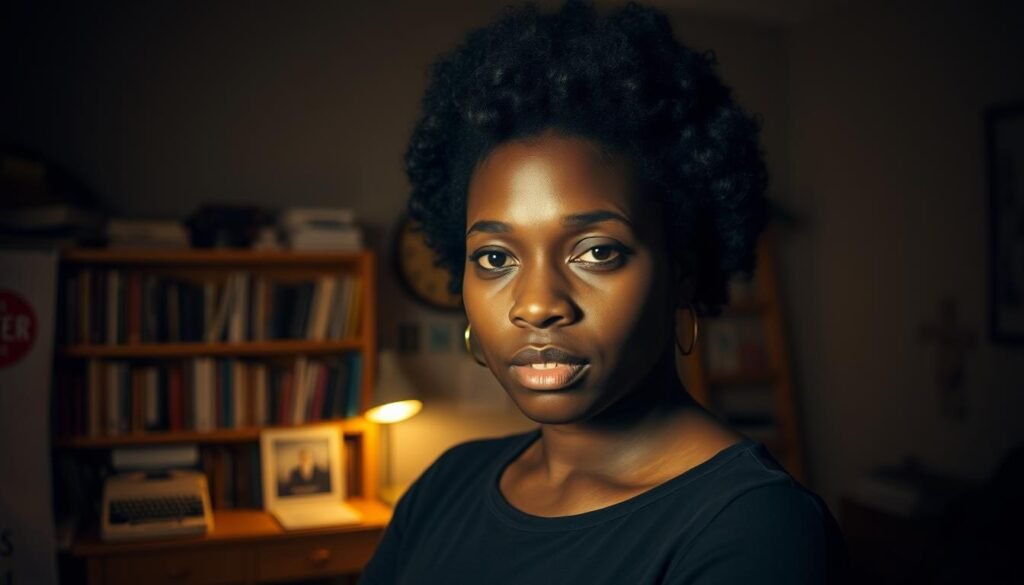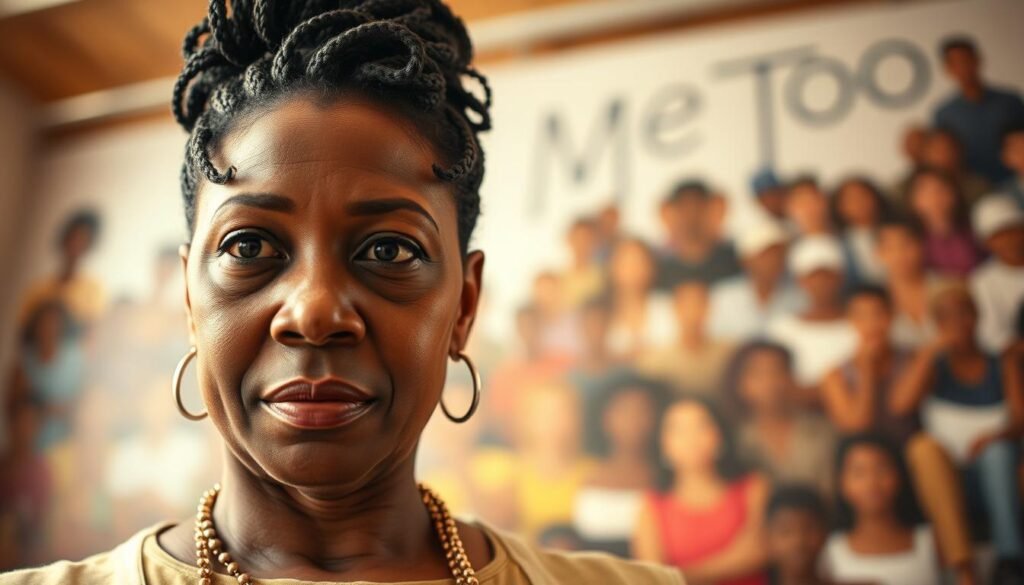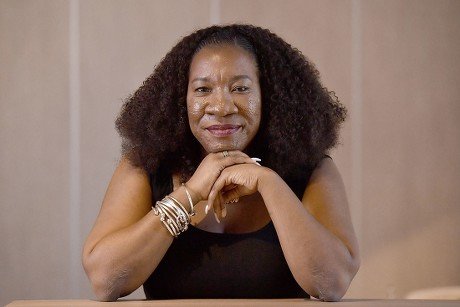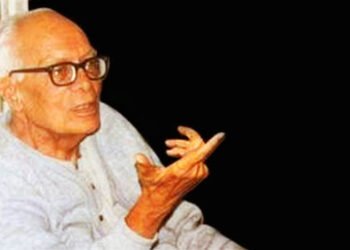What if two simple words could change how the world talks about sexual violence? That’s exactly what happened when one brave activist from New York started a movement that would eventually sweep the globe.
Tarana Burke began her work in 2006 with a youth program focused on supporting survivors. She created the “Me Too” phrase to help young women share their stories with empathy and support.
For years, this important work remained mostly local. Then in 2017, everything changed. When the Harvey Weinstein scandal broke, actress Alyssa Milano shared the phrase on social media.
Suddenly, millions of women worldwide began sharing their own experiences using #MeToo. The movement became a global phenomenon almost overnight.
Time magazine recognized Burke’s incredible impact by naming her a Person of the Year. Her work with the liberation birth movement continues to inspire change and support survivors everywhere.
Key Takeaways
- Tarana Burke founded the Me Too movement as a youth program in 2006
- The movement initially focused on addressing sexual violence in local communities
- In 2017, the phrase went viral through social media and became a global phenomenon
- The Harvey Weinstein scandal played a key role in popularizing the movement
- Burke was named Time Person of the Year for her groundbreaking work
- The movement emphasizes empathy and sharing personal stories
- What began as local activism transformed into worldwide awareness about sexual violence
Early Life and Education
From Catholic school classrooms to neighborhood organizing, early experiences shaped an activist’s understanding of justice. The Bronx roots provided a powerful foundation for future work supporting survivors.

Bronx Roots and Formative Years
Growing up in the vibrant borough of New York, she attended Catholic primary school. Later, she continued her education at Herbert H. Lehman High School.
These early years in the Bronx exposed her to diverse communities and social issues. The urban environment cultivated her perspective on inequality and justice.
This background would later inform her approach to community organizing and survivor support.
Education at Alabama State University and Auburn
She pursued higher education at Alabama State University, a historically Black institution. This experience proved significant for her development as an activist.
Attending an HBCU provided cultural context and historical awareness. She later continued studies at Auburn University at Montgomery.
These educational experiences built the foundation for her career addressing social justice issues.
Early Activism with 21st Century Youth Leadership Movement
Her passion for change began in the late 1980s through youth development work. She joined the 21st Century Youth Leadership Movement as a young participant.
This program focused on empowering young people, particularly women of color. It introduced her to organizing strategies and community engagement.
During college years, she organized press conferences and protests for racial justice. She addressed critical issues like discrimination and housing inequality.
This early activism connected directly to her later work with sexual violence survivors. The experiences shaped her commitment to supporting vulnerable communities.
Economic justice and empowerment became central themes in her approach. These formative years established patterns that would define her career.
Career and Activism Beginnings
After completing her education, a relocation to historic Alabama territory opened new avenues for civil rights advocacy. This period marked significant professional growth and deeper engagement with community organizing.
Move to Selma and Community Organizing Work
In the late 1990s, the activist moved to Selma, Alabama. This city held deep significance in American civil rights history.
She began working directly with survivors of sexual violence. This experience profoundly shaped her understanding of support systems.
Her work focused on empowering vulnerable communities through various programs. The Alabama environment provided rich ground for developing her approach to social justice issues.
Founding Just Be Inc. for Young Women of Color
In 2003, she established Just Be Inc. as a nonprofit organization. This initiative specifically served Black girls aged 12 to 18.
The program created safe spaces for young women of color to develop and thrive. It addressed various challenges facing this demographic.
Just Be Inc. focused on empowerment through education and support. The organization became a vital resource for youth in the community.
Work with National Voting Rights Museum and Art Sanctuary
She served as curatorial consultant and special projects director at the National Voting Rights Museum. This role involved preserving the history of voting rights struggles.
She helped organize the annual Selma Bridge Crossing Jubilee. This event commemorated the historic Selma Voting Rights Struggle.
In 2008, she moved to Philadelphia and worked at Art Sanctuary. This organization focused on African American arts and culture.
She also consulted for the 2014 film Selma about the voting rights marches. Later, she became Senior Director at Girls for Gender Equity in Brooklyn.
Throughout these roles, her work consistently centered on empowering young women of color. Each position contributed to her comprehensive approach to addressing social justice issues.
Tarana Burke and the Me Too Movement
Sometimes the most powerful movements begin with simple words spoken at the right moment. This movement started with two words that would echo across continents.
Origins of the “Me Too” Phrase in 2006
The phrase “Me Too” emerged from a deeply personal moment. In 1996, a young woman shared her experience of sexual abuse with the activist.
This confession inspired the creation of a powerful support system. Ten years later, the phrase became the foundation for a new movement.
It began as a local initiative to address sexual violence in communities. The goal was creating safe spaces for survivors to share their stories.
This approach emphasized empathy and mutual support. For over a decade, the movement grew quietly but steadily.

The 2017 Viral Hashtag and Global Impact
Everything changed in October 2017 when the Harvey Weinstein scandal broke. Actress Alyssa Milano shared the phrase on social media.
She encouraged women worldwide to use #MeToo if they experienced sexual assault or harassment. The response was immediate and massive.
Within hours, the hashtag went viral across platforms. Twitter alone saw over 19 million uses in one year.
Milano quickly credited the original creator of the phrase. The movement transformed from local to global overnight.
Time magazine recognized this impact by naming the activist and other “silence breakers” as Person of the Year. This acknowledgment highlighted the movement’s significance.
Establishing me too. International and Ongoing Work
In 2018, the movement formalized as me too. International. This organization serves as a container for the growing initiative.
The founder serves as Chief Vision Officer, guiding the organization‘s direction. The work continues through various programs and initiatives.
Two New York Times bestsellers emerged from this journey. These books explore vulnerability, shame resilience, and liberation.
The movement maintains its focus on supporting survivors of sexual assault. It continues creating spaces for sharing and healing.
What began as two simple words now resonates across the world. The movement keeps evolving while staying true to its original purpose.
Conclusion
Honors and recognition continue to highlight the profound impact of one woman’s courageous work against sexual violence. As Senior Director at Girls for Gender Equity, she guides empowerment programs for young women.
Major awards include being named Time Person of the Year and receiving the Sydney Peace Prize. Her appearance at the Golden Globes with Michelle Williams brought further attention to survivors’ stories.
The movement maintains its vital mission of creating safe spaces and promoting empathy. It continues supporting those affected by abuse through the organization’s ongoing work.
This visionary leader resides in New York City, raising her daughter while advancing global conversations about justice. Her contribution to women’s rights remains transformative and enduring.
FAQ
What is the origin of the “Me Too” phrase?
The activist began using the phrase in 2006 while working with young survivors of sexual violence through her organization, Just Be Inc. It was created to foster empathy and solidarity among survivors, letting them know they were not alone.
How did the Me Too movement become viral?
The movement gained global attention in 2017 when the hashtag #MeToo went viral on social media, following sexual abuse allegations against Harvey Weinstein. This sparked a worldwide conversation about sexual harassment and assault.
What is the mission of the Me Too movement today?
The movement, through me too. International, focuses on supporting survivors, advocating for systemic change, and providing resources for healing. It addresses issues like gender equity and works to end sexual violence.
What other work has Tarana Burke done besides the Me Too movement?
She has a long history in activism, including community organizing in Selma, founding programs for young women of color, and working with institutions like the National Voting Rights Museum to promote social justice and youth leadership.
Has Tarana Burke received any major recognition for her work?
Yes, she was named one of Time magazine’s Persons of the Year in 2017 for her role in empowering survivors and sparking a global reckoning on sexual violence.





